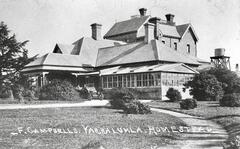Rediscovering Ginninderra:
Mr Frederick Campbell
Born: 1846; Died: 1928

Mr. F. Campbell. Death of well-known pastoralist
Mr Frederick Campbell, formerly owner of Yarralumla Station, now portion of the Federal Territory, and more recently owner of Red Hill Station, Tumut District, and a member of one of the State's oldest families, died at Narrandera last Sunday week in his 84th year. Mr. Campbell was a grandson of Robert Campbell, the original grantee of Duntroon, who received large areas of land in what is now the Federal Capital Territory as compensation for two of his trading vessels which were seized in Sydney Cove, and sent to South Africa for supplies to ward off a famine in the infant colony. Robert Campbell, who first visited Australia in 1796 as the representative of a mercantile firm, eventually settled on his property at Duntroon. and the historic estate remained in the family until resumed by the Commonwealth in 1913.
Charles Campbell, the third son of Robert Campbell, and father of Mr. Frederick Campbell, was also associated with Duntroon as manager, and, in addition, bought Belconon Station [Belconnen Farm] from Charles Sturt in 1837, and acquired land at Ginninderra. Mr. Frederick Campbell was only eight years old when he was taken to England by his parents. He was educated at Cholmeley School, High Gate, London, where he was a class-mate of Marcus Clark, the author. He returned to Sydney in 1864, and after a year at the University went for colonial experience to the late Mr. Godfrey McKinnon, of North Goonambil, Urana.
In 1868 he became manager of Tryphena Downs sheep station, on the McKenzie River, west of Rockhampton, Queensland, and after selling that station for its owners had three years' experience of mercantile life in Sydney with Campbell and Co., for whom he frequently acted as wool buyer. In 1874 he bought Bundabarena [Bundabarina] cattle station, on the Barwon, and on the sale of that property in 1877 he took over the management of Duntroon for his uncle, Mr. George Campbell.
Mr. Campbell's association with Yarralumla dated from 1881, when he bought that property from the Gibbes family. Yarralumla comprised about 8000 acres, and when he received his father's property at Belconon on the latters' death in 1888, he owned about 39,000 acres freehold. Under his direction Yarralumla became a model station. Heavy forest land was converted into grazing and cultivation paddocks, marshy country was dried by about 500 miles of drains, and the whole area was made practically rabbit-proof. The clip, from merinos of Boonooke and Wanganella extraction, became one of the most valuable in the State.
Mr. Campbell resided at Yarralumla until it was resumed as a residence for the Governor-General, and then left to control Cooinbill, a property he had acquired in Riverina. About 12 years ago he bought Red Hill Station from the late Patrick Kiley, who retired to Darah, near Cootamundra, which his son, Mr. J. R. Kiley, managed. Mr. Campbell resided at Red Hill for some years, making it his headquarters from which he controlled his properties in Riverina.
During his residence in the present Federal Territory he took a keen interest in all local affairs. For many years he was a member of the Queanbeyan Pastures Protection Board, and for some time also was president of the local Farmers and Settlers' Association. He sat on the Walgett Bench in 1875, was associated with the Queanbeyan Licensing Bench, and, from 1879, was a member of the various synods of the Goulburn diocese. He was interested also in sport, and assisted in the formation of the Wallaroo football team in 1870.
He is survived by Mrs. Campbell, his second wife, by Miss Campbell and another daughter, Mrs. Charles Newman, wife of Captain Newman, now living in India, and by one son, Mr. Walter Malcolm Campbell. The funeral took place in the family vault in St. John's cemetery, Parramatta, on Monday last.
A service was held in the church by the Bishop of Goulburn (Dr. Radford), assisted by the Rev. S. M. Johnstone, rector of St. John's, and the Rev. W. H. Mullens, rector of St. Mark's, Granville. Dr. Radford also performed the last rites at the vault. In a brief address, the Bishop referred to the integrity and generosity of Mr. Campbell, and to his un-tiring devotion to the work of the Church throughout his life. Mr. Campbell, he said, had been secretary of the parish church to which he belonged for a generation. He was very liberal, and showed keen interest in the religious education of the children and of the clergy.
The mourners included Mr. Walter Campbell (son), Miss S. J. Campbell (daughter), Messrs F. A. Campbell and A. D. Campbell (cousins), George Campbell (nephew), Dr. Granville Sharp, Messrs. Shaw (representing the Permanent Trustee Co. Ltd.), Wilfred C. Metcalfe, F. J. L., L. R. and R. Dunlop, Arthur Cummins, A. Grafton Purves, P. C. Mowle, Captain F. J. C Fitzgerald, W. B. Tiley, Powell, Neville Hoare, J. Reid, Westmacott, Mr. and Mrs. L. Hey Sharp, Miss Farr, Mr. and Mrs. E. A. Brassey, Mrs. Thornton, and Miss Walsh.
[Tumut and Adelong Times, Tuesday 28 August 1928, p. 1]
Related Photos
References
- Frederick Campbell Obituaries Australia
- Newman R.S.C. Frederick Campbell of Yarralumla. Frederick Campbell of Yarralumla: a forgotten pioneer pastoralist. Journal of the Rotal Australian Historical Society, 2007.


